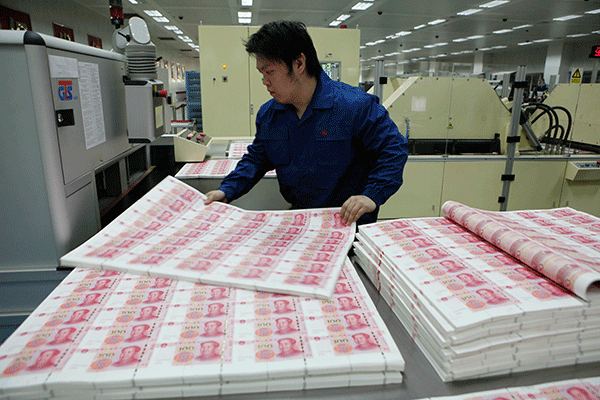The People's Bank of China regards its bills as the country's business cards, so every effort is made to ensure they remain clean and undamaged, report Cui Jia in Nanjing and Yancheng, Jiangsu province, and Chen Jia in Beijing.
 |
|
A worker prepares to cut 100 yuan bank notes printed on large sheets into separate bills at the Beijing Banknote Printing Co on Oct 29. [Yan Ping / for China Daily] |
The bright colors meant the piles stood out from the other biomass materials, such as wooden pallets and doors, ready to be burned to generate electricity. Unlike the other waste material, though, the colored piles were special because the blocks were once bills, the green ones were worth 10 yuan ($1.60) each, while the red signified 100 yuan bills.
Business as usual
On Thursday, as the People's Bank of China issued the 2015 edition of the 100 yuan bill, the routine work of destroying old and damaged notes continued as usual.
The PBOC regards renminbi, or "people's currency", bank notes as the country's business cards. It has a responsibility to ensure they remain in mintcondition, so destroying old and damaged notes is as important as printing new ones.
The improved optical features included in the new 100 yuan bill are designed to strengthen protection against counterfeiting, and a number of advanced technologies have been developed to make it easier for vending machines and ATMs to "read" the bills and ensure that they are genuine. The new bills have a more obvious security strip and the central "100" has been rendered in a special shade of red.
Many of the new bills were printed at the Beijing Banknote Printing Co, one of six facilities owned and operated by the China Banknote Printing and Minting Corp, which is supervised by the PBOC.
The production process has four stages: Offset print for the shading; intaglio print for the main pattern including the portrait of Mao Zedong, which is raised above the surface as a special anti-counterfeiting measure; printing the serial numbers and quality control; and finally, cutting and packing. The process usually lasts about one month for each note.
Shao Guowei, chief technology officer of the China Banknote Printing and Minting Corp, who has worked in the sector for 37 years, said the bills are part of the country's image, and the artistic quality of the design should be improved in tandem with advanced anti-counterfeiting technologies.
According to the central bank, the 2015 edition bills will circulate in parallel with previous editions and will have the same face value.
Shang Zhiyu, an official with the PBOC's Currency, Gold and Silver Bureau, said the central bank will gradually collect dirty and damaged bank notes and replace them with the new issue to ensure that all the bills in circulation are clean and undamaged.
